Abstract
A method for isolating pig colon mucin in a soluble high-molecular-weight form, suitable for addition to bacterial growth media, is described. This preparation was utilized as a sole carbohydrate energy source by two strains of Bacteroides fragilis. The extent of degradation was compared with that of commercial pig gastric mucin by the same strains. Gas-liquid chromatographic analysis of the mucin carbohydrates and gel chromatography of the preparations were carried out before and after in vitro degradation. The mucin carbohydrates were utilized only to a very limited extent, colon mucin being more resistant to degradation than gastric mucin. Both mucins chromatographed at or near the excluded volume on Sepharose 4B, and only in the case of ATCC 25285 grown on gastric mucin was a significant degradation peak detected. If mucins are degraded in vivo by the sequential action of several bacteria, a pure culture in vitro might be expected to degrade mucins to a limited extent only. Techniques previously used to examine mucin utilization by pure cultures may have overlooked limited mucin degradation demonstrated by the methods used in this work.
Full text
PDF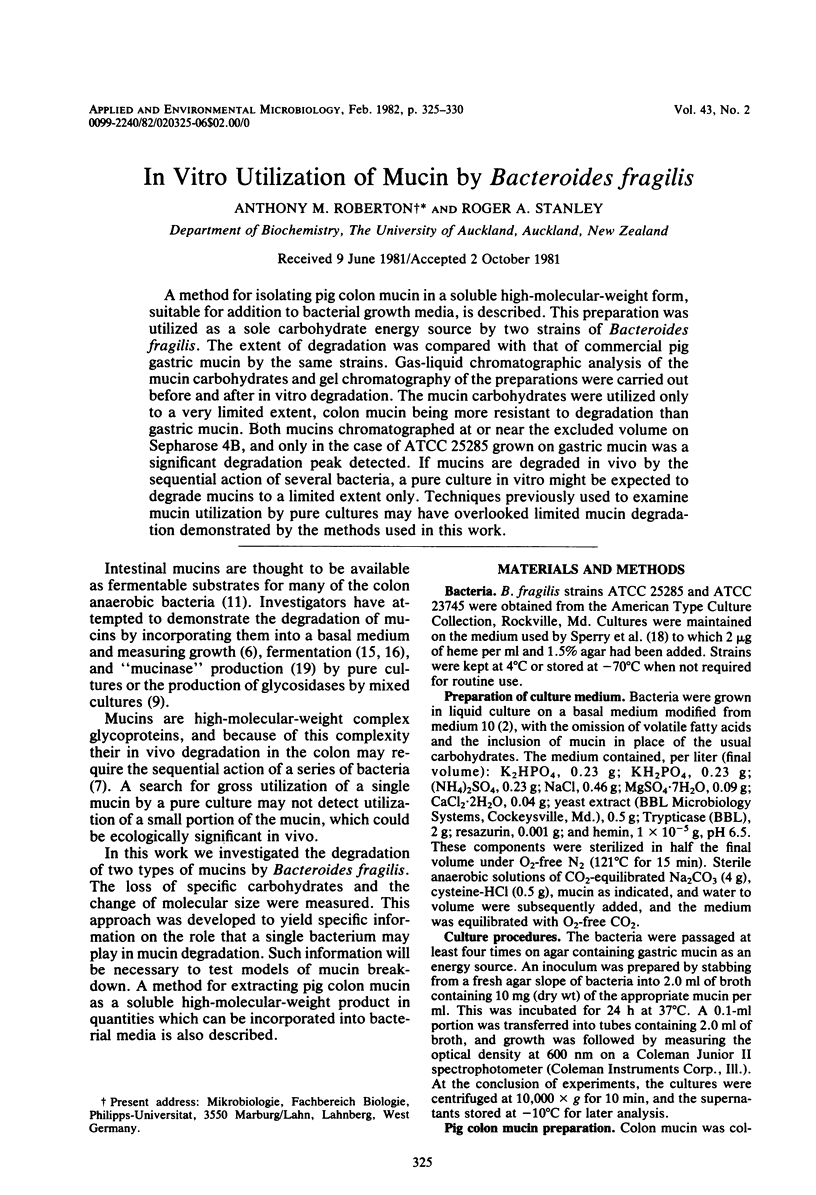
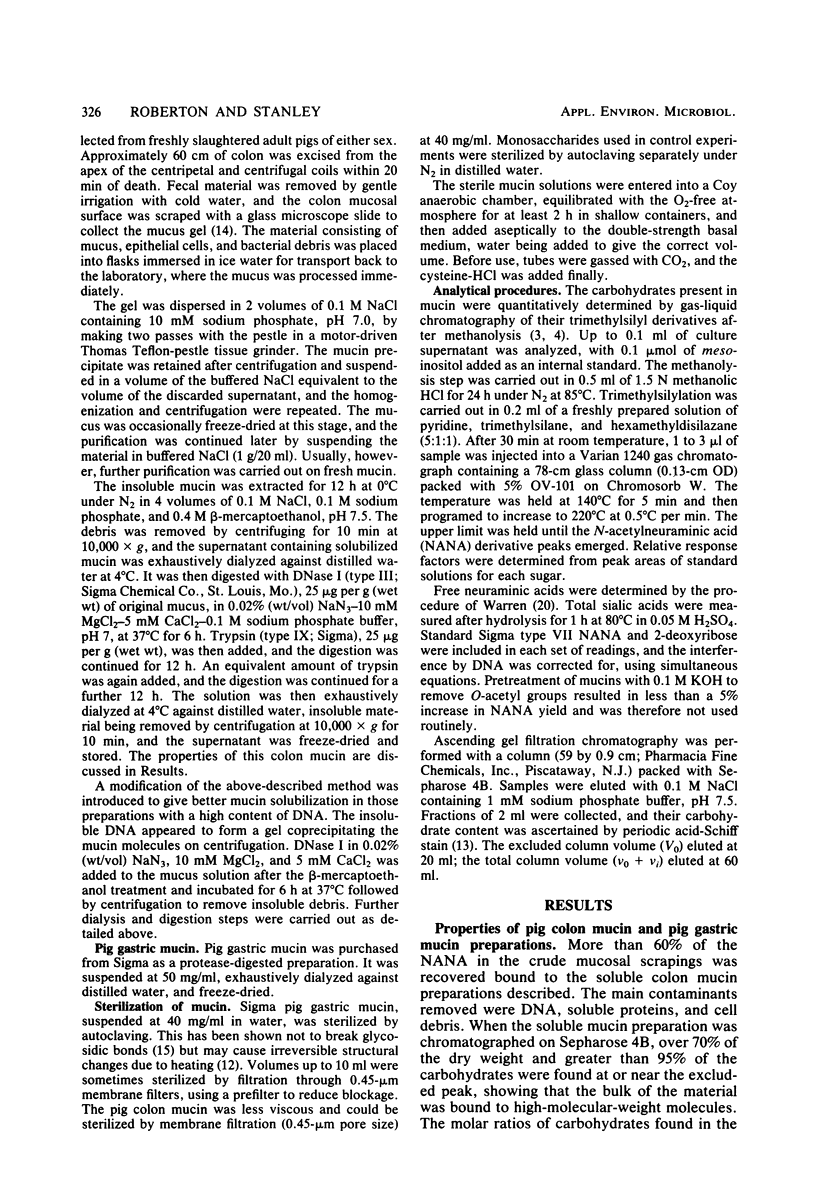
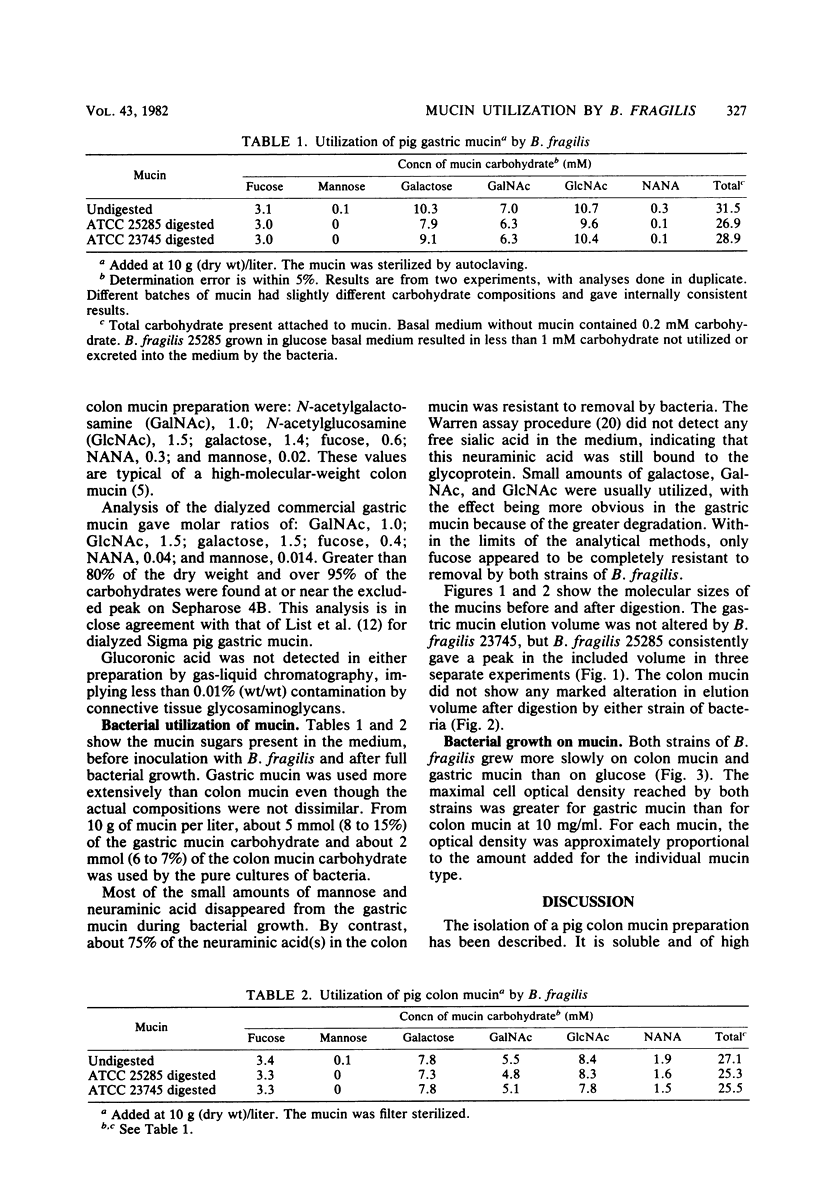
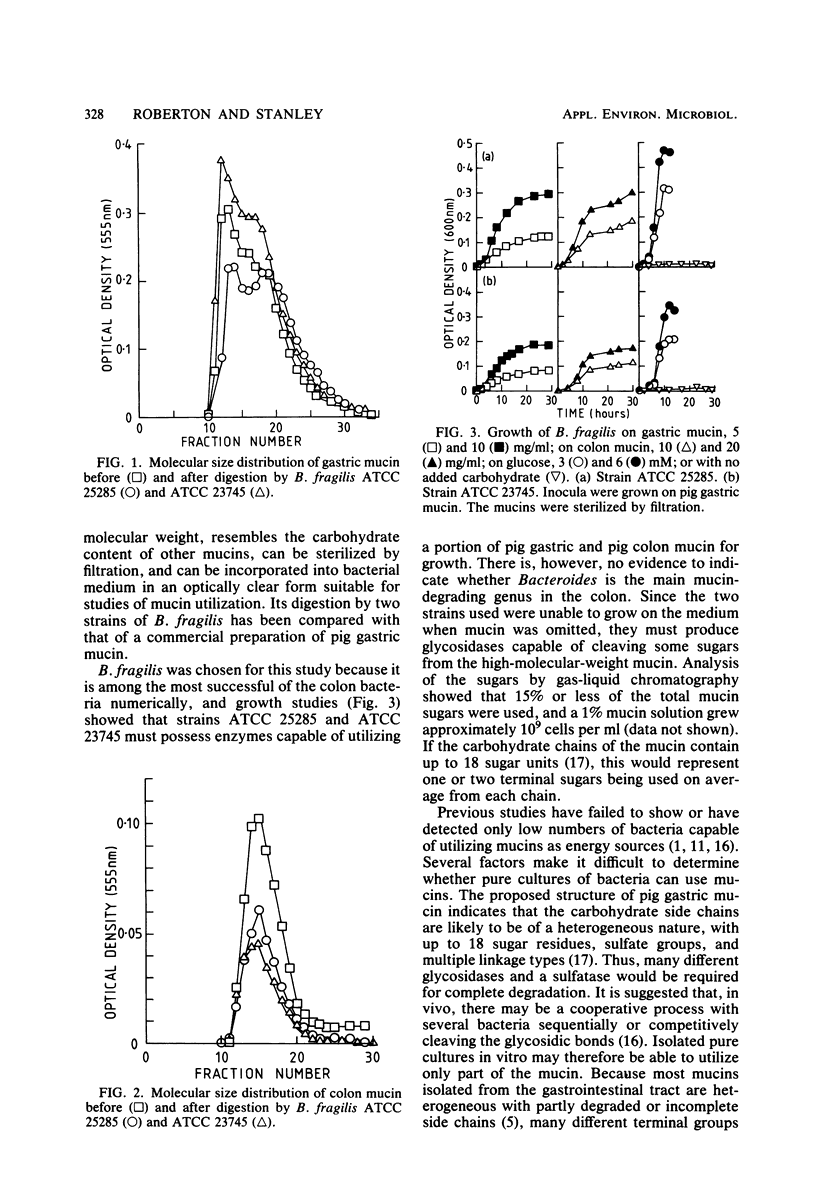
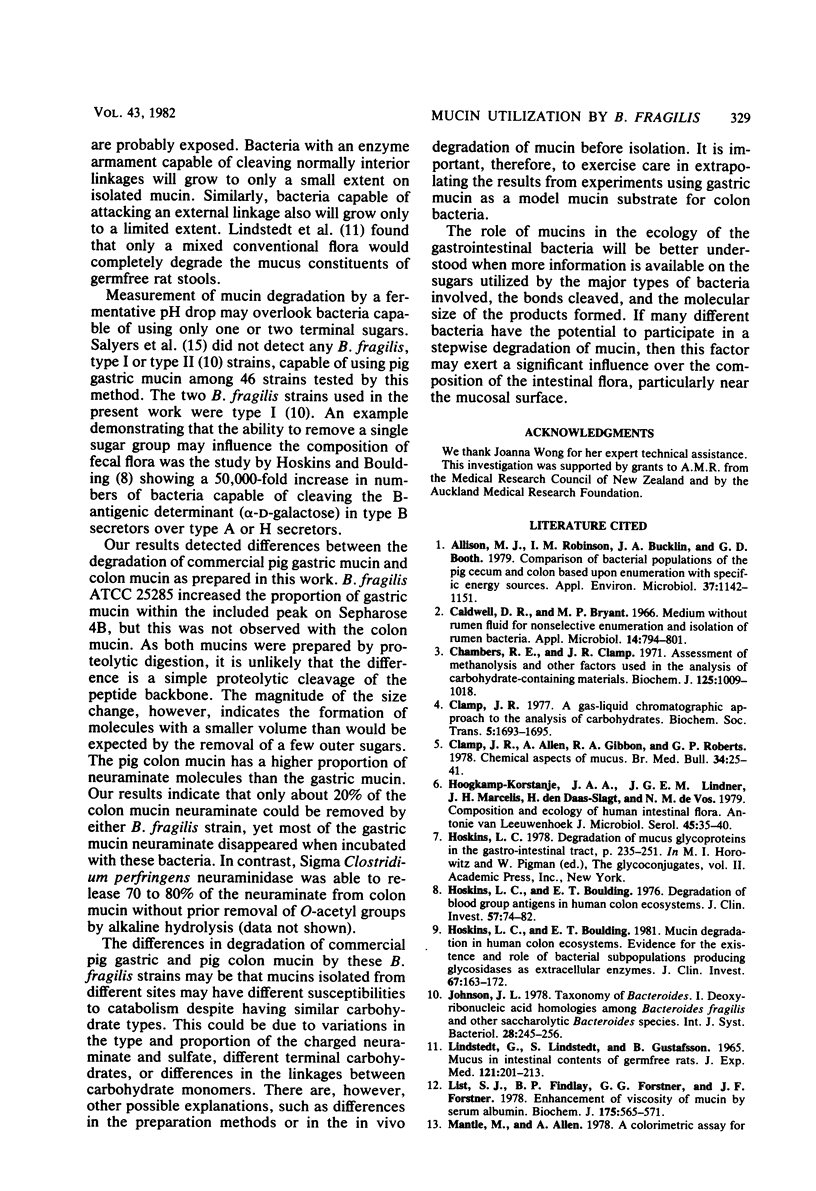
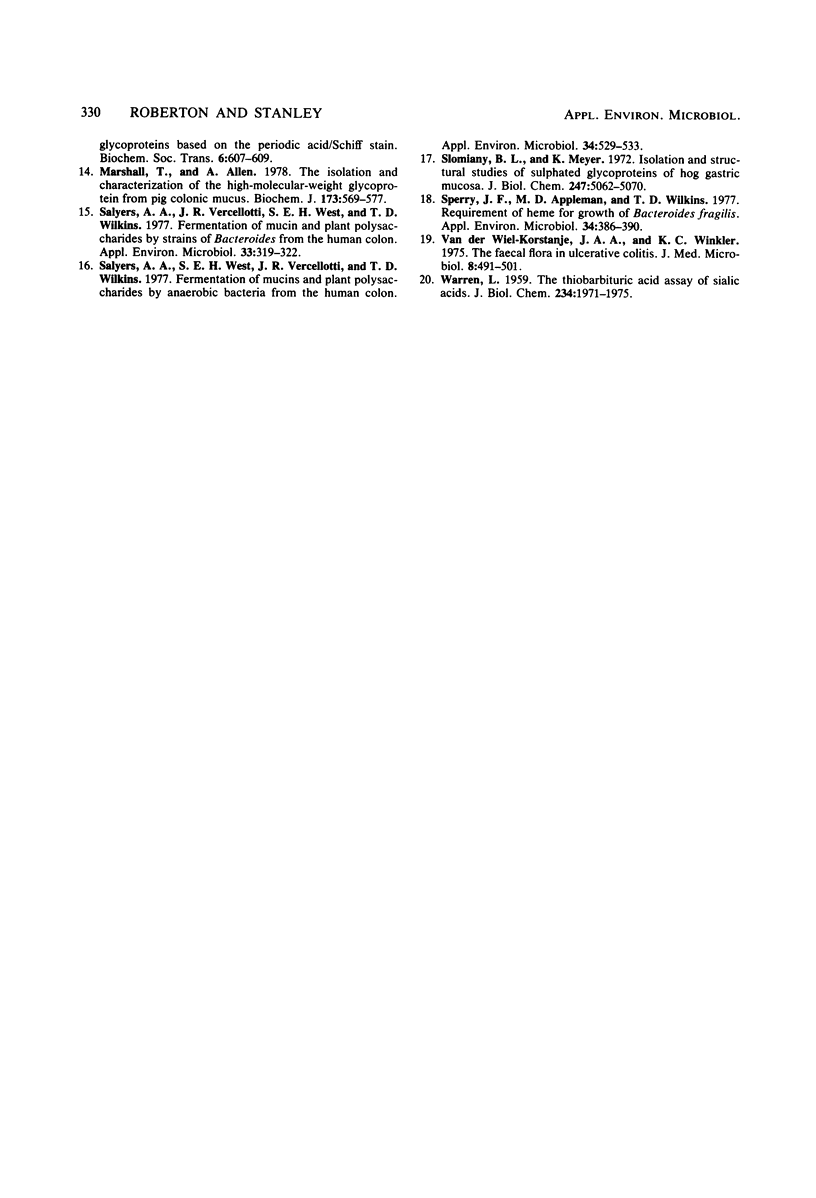
Selected References
These references are in PubMed. This may not be the complete list of references from this article.
- Allison M. J., Robinson I. M., Bucklin J. A., Booth G. D. Comparison of bacterial populations of the pig cecum and colon based upon enumeration with specific energy sources. Appl Environ Microbiol. 1979 Jun;37(6):1142–1151. doi: 10.1128/aem.37.6.1142-1151.1979. [DOI] [PMC free article] [PubMed] [Google Scholar]
- Caldwell D. R., Bryant M. P. Medium without rumen fluid for nonselective enumeration and isolation of rumen bacteria. Appl Microbiol. 1966 Sep;14(5):794–801. doi: 10.1128/am.14.5.794-801.1966. [DOI] [PMC free article] [PubMed] [Google Scholar]
- Chambers R. E., Clamp J. R. An assessment of methanolysis and other factors used in the analysis of carbohydrate-containing materials. Biochem J. 1971 Dec;125(4):1009–1018. doi: 10.1042/bj1251009. [DOI] [PMC free article] [PubMed] [Google Scholar]
- Clamp J. R. A gas-liquid chromatographic approach to the analysis of carbohydrates. Biochem Soc Trans. 1977;5(6):1693–1695. doi: 10.1042/bst0051693. [DOI] [PubMed] [Google Scholar]
- Clamp J. R. Chemical aspects of mucus. General considerations. Br Med Bull. 1978 Jan;34(1):25–27. doi: 10.1093/oxfordjournals.bmb.a071455. [DOI] [PubMed] [Google Scholar]
- Hoogkamp-Korstanje J. A., Lindner J. G., Marcelis J. H., den Daas-Slagt H., de Vos N. M. Composition and ecology of the human intestinal flora. Antonie Van Leeuwenhoek. 1979;45(1):35–40. doi: 10.1007/BF00400776. [DOI] [PubMed] [Google Scholar]
- Hoskins L. C., Boulding E. T. Degradation of blood group antigens in human colon ecosystems. II. A gene interaction in man that affects the fecal population density of certain enteric bacteria. J Clin Invest. 1976 Jan;57(1):74–82. doi: 10.1172/JCI108271. [DOI] [PMC free article] [PubMed] [Google Scholar]
- Hoskins L. C., Boulding E. T. Mucin degradation in human colon ecosystems. Evidence for the existence and role of bacterial subpopulations producing glycosidases as extracellular enzymes. J Clin Invest. 1981 Jan;67(1):163–172. doi: 10.1172/JCI110009. [DOI] [PMC free article] [PubMed] [Google Scholar]
- LINDSTEDT G., LINDSTEDT S., GUSTAFSSON B. E. MUCUS IN INTESTINAL CONTENTS OF GERMFREE RATS. J Exp Med. 1965 Feb 1;121:201–213. doi: 10.1084/jem.121.2.201. [DOI] [PMC free article] [PubMed] [Google Scholar]
- List S. J., Findlay B. P., Forstner G. G., Forstner J. F. Enhancement of the viscosity of mucin by serum albumin. Biochem J. 1978 Nov 1;175(2):565–571. doi: 10.1042/bj1750565. [DOI] [PMC free article] [PubMed] [Google Scholar]
- Mantle M., Allen A. A colorimetric assay for glycoproteins based on the periodic acid/Schiff stain [proceedings]. Biochem Soc Trans. 1978;6(3):607–609. doi: 10.1042/bst0060607. [DOI] [PubMed] [Google Scholar]
- Marshall T., Allen A. The isolation and characterization of the high-molecular-weight glycoprotein from pig colonic mucus. Biochem J. 1978 Aug 1;173(2):569–578. doi: 10.1042/bj1730569. [DOI] [PMC free article] [PubMed] [Google Scholar]
- Salyers A. A., Vercellotti J. R., West S. E., Wilkins T. D. Fermentation of mucin and plant polysaccharides by strains of Bacteroides from the human colon. Appl Environ Microbiol. 1977 Feb;33(2):319–322. doi: 10.1128/aem.33.2.319-322.1977. [DOI] [PMC free article] [PubMed] [Google Scholar]
- Salyers A. A., West S. E., Vercellotti J. R., Wilkins T. D. Fermentation of mucins and plant polysaccharides by anaerobic bacteria from the human colon. Appl Environ Microbiol. 1977 Nov;34(5):529–533. doi: 10.1128/aem.34.5.529-533.1977. [DOI] [PMC free article] [PubMed] [Google Scholar]
- Slomiany B. L., Meyer K. Isolation and structural studies of sulfated glycoproteins of hog gastric mucosa. J Biol Chem. 1972 Aug 25;247(16):5062–5070. [PubMed] [Google Scholar]
- Sperry J. F., Appleman M. D., Wilkins T. D. Requirement of heme for growth of Bacteroides fragilis. Appl Environ Microbiol. 1977 Oct;34(4):386–390. doi: 10.1128/aem.34.4.386-390.1977. [DOI] [PMC free article] [PubMed] [Google Scholar]
- WARREN L. The thiobarbituric acid assay of sialic acids. J Biol Chem. 1959 Aug;234(8):1971–1975. [PubMed] [Google Scholar]
- van der Wiel-Korstanje J. A., Winkler K. C. The faecal flora in ulcerative colitis. J Med Microbiol. 1975 Nov;8(4):491–501. doi: 10.1099/00222615-8-4-491. [DOI] [PubMed] [Google Scholar]


